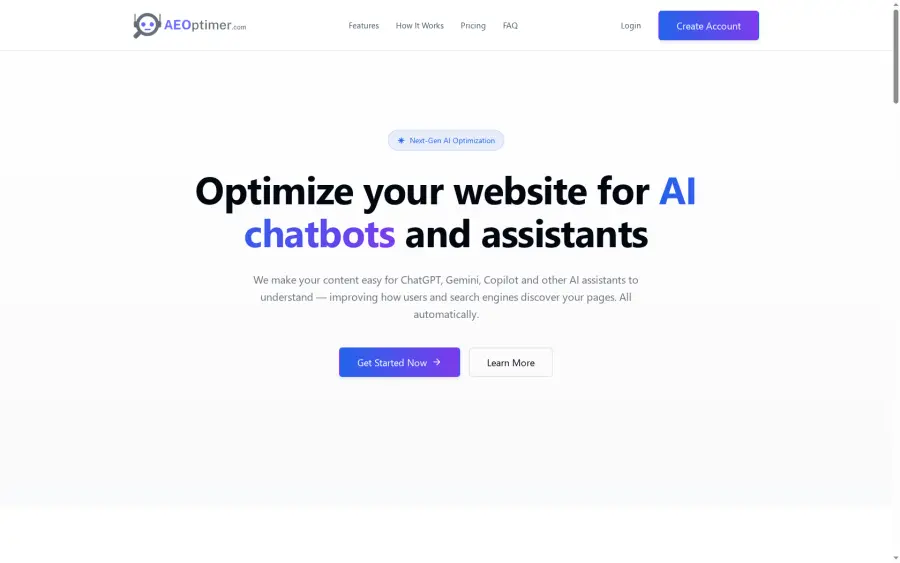What Is an AI Sitemap? Complete Guide for 2024

Search engines are more intelligent than ever, but even the smartest AI can struggle with poorly structured websites. For american businesses aiming to stand out online, adopting advanced sitemap solutions is critical. Studies show that AI-powered discovery boosts web visibility by up to 62 percent compared to traditional sitemaps. Understanding AI sitemaps and their unique ability to map content relationships can help your website become impossible for digital assistants and search algorithms to ignore.
Table of Contents
- AI Sitemaps Defined And Core Concepts
- Types Of AI Sitemaps And Key Differences
- How AI Sitemaps Work With AI Assistants
- SEO Benefits And Discoverability Impacts
- Best Practices For Implementing AI Sitemaps
Key Takeaways
| Point | Details |
|---|---|
| AI Sitemaps Enhance Understanding | AI sitemaps utilize semantic metadata to provide deeper insights into content relationships, improving AI and search engine comprehension. |
| Types of AI Sitemaps | Different types, including Semantic, Structured, Dynamic, and Relational AI Sitemaps serve various content needs for AI discoverability. |
| SEO and Visibility Benefits | By leveraging AI sitemaps, websites improve search rankings and visibility through enhanced semantic indexing and content categorization. |
| Best Practices for Implementation | Focus on developing granular metadata and clear content hierarchies to enable effective machine parsing and comprehension. |
AI Sitemaps Defined and Core Concepts
An AI sitemap represents a sophisticated evolution of traditional XML sitemaps, designed to help artificial intelligence systems understand and navigate website content more intelligently. According to Kaiasm, these enhanced sitemaps incorporate semantic layers using advanced technologies like RDF, OWL, and SKOS to define intricate content relationships and domain knowledge.
Unlike standard sitemaps that merely list web pages, AI sitemaps provide a rich contextual framework for machine learning algorithms. They go beyond simple URL listings by embedding semantic metadata that helps AI assistants comprehend the deeper meaning, structure, and interconnectedness of website content. This means search engines and AI tools can more accurately interpret the purpose, relevance, and hierarchical relationships between different pages and information segments.
Key characteristics of AI sitemaps include:
- Semantic metadata embedding
- Advanced content relationship mapping
- Enhanced machine learning compatibility
- Deeper contextual understanding for AI systems
By leveraging these advanced mapping techniques, websites can dramatically improve their discoverability and interpretability for AI-driven search tools and intelligent assistants. Learn more about AI website discovery in our comprehensive guide on how AI assistants find websites.
Types of AI Sitemaps and Key Differences
AI sitemaps are not a one-size-fits-all solution, and different types emerge to address specific website needs and AI discovery requirements. Semantic AI Sitemaps represent the most advanced category, designed to provide deep contextual understanding for machine learning algorithms. These sitemaps incorporate complex metadata layers that map out intricate content relationships, domain knowledge, and hierarchical structures far beyond traditional URL listings.
Another critical classification includes Structured AI Sitemaps, which focus on creating precise, machine-readable content schemas. These sitemaps prioritize clean, standardized information architecture that allows AI systems to quickly parse and understand website content. They typically include detailed metadata about page types, content categories, and semantic connections between different website sections.
Key variations of AI sitemaps can be categorized as:

- Semantic AI Sitemaps (deep contextual understanding)
- Structured AI Sitemaps (precise content schemas)
- Dynamic AI Sitemaps (real-time content updates)
- Relational AI Sitemaps (interconnected content mapping)
Learn more about website optimization strategies for AI in our comprehensive guide, which explores how different sitemap approaches can dramatically enhance your website’s AI discoverability and indexing potential. These advanced mapping techniques represent a significant leap forward in helping websites communicate more effectively with intelligent search algorithms and AI assistants.
How AI Sitemaps Work with AI Assistants
AI sitemaps serve as a sophisticated communication bridge between websites and intelligent digital assistants, enabling more nuanced and accurate content discovery. According to Kaiasm, these advanced sitemaps utilize machine-readable relationships to help AI systems understand domain knowledge, incorporating semantic layers that dramatically improve content interpretation and retrieval processes.
The interaction between AI sitemaps and AI assistants operates through a complex mechanism of semantic mapping and contextual understanding. Intelligent parsing allows these assistants to navigate beyond traditional keyword matching, instead comprehending the deeper relationships, hierarchies, and meaningful connections within website content. This approach transforms how AI tools like ChatGPT, Gemini, and Copilot interact with digital information, moving from simple indexing to intelligent comprehension.
Critical interaction mechanisms include:
- Semantic relationship mapping
- Contextual content understanding
- Hierarchical information parsing
- Dynamic content relationship detection
Learn more about how AI assistants discover and interact with websites in our comprehensive guide, which explores the intricate ways intelligent systems navigate and interpret digital content. By implementing robust AI sitemaps, websites can significantly enhance their discoverability and ensure more accurate, meaningful interactions with cutting-edge AI technologies.
SEO Benefits and Discoverability Impacts
AI sitemaps represent a revolutionary approach to enhancing website visibility and search engine optimization, providing unprecedented opportunities for digital content discovery. Semantic indexing transforms how search engines and AI assistants understand and rank website content, moving beyond traditional keyword-based approaches to more nuanced, context-aware evaluation.
The strategic implementation of AI sitemaps directly impacts a website’s discoverability by creating intricate content relationship maps that help intelligent algorithms more accurately assess relevance and importance. This advanced approach enables websites to communicate their content’s depth, structure, and contextual significance more effectively, potentially improving search rankings and AI assistant interaction rates. By providing rich, machine-readable metadata, websites can ensure their most valuable content receives appropriate recognition and prioritization.
![]()
Critical SEO and discoverability benefits include:
- Enhanced semantic content understanding
- Improved search engine ranking potential
- More accurate content categorization
- Increased visibility for complex or niche content
- Better performance in AI-driven search results
Discover advanced content discoverability strategies in our comprehensive guide, which explores cutting-edge techniques for maximizing your website’s visibility in an increasingly intelligent digital landscape. By adopting AI sitemap technologies, businesses can stay ahead of evolving search algorithms and ensure their most valuable content reaches the right audience at the right time.
Best Practices for Implementing AI Sitemaps
Implementing AI sitemaps requires a strategic approach that goes beyond traditional sitemap creation, focusing on rich semantic metadata and intelligent content structuring. Comprehensive semantic mapping involves meticulously organizing content to create clear, machine-readable relationships that help AI systems comprehend the nuanced context and hierarchical significance of your website’s information.
Successful AI sitemap implementation demands a multi-layered approach that prioritizes depth, accuracy, and dynamic content representation. Web developers and content strategists must carefully craft detailed metadata, ensuring each page includes comprehensive descriptive elements that transcend simple keyword tagging. This includes developing intricate content taxonomies, embedding structured data annotations, and creating clear semantic connections between different content sections that AI algorithms can easily parse and understand.
Key implementation best practices include:
- Develop granular, descriptive semantic metadata
- Create clear content hierarchies and relationships
- Use standardized schema markup languages
- Regularly update and refresh sitemap content
- Ensure consistent and precise content categorization
- Implement machine-readable structured data formats
Explore our comprehensive guide on creating AI-friendly website content to understand how strategic content optimization can dramatically improve your website’s AI discoverability. By adopting these advanced implementation strategies, websites can transform their digital presence, making their content more intelligible and accessible to cutting-edge AI technologies.
Unlock the Full Potential of Your Website with AI Sitemaps
The article highlights the challenge of making websites more understandable and discoverable by AI assistants through advanced semantic metadata and AI sitemaps. Many website owners struggle to implement these complex structured data layers and keep their content dynamically updated for AI systems like ChatGPT or Gemini. If you want to overcome these obstacles while ensuring your website communicates clearly with intelligent search algorithms you need a solution that automates the entire process without requiring technical expertise.
aeoptimer.com is specifically designed to enhance your website’s AI discoverability by automatically adding structured data and AI-friendly enhancements that align with the latest AI search trends. You can rely on our SaaS platform to crawl and optimize your pages monthly keeping your content relevant and machine-readable without changing your site’s appearance. This means better semantic content understanding and higher chances of ranking well in AI-powered results.
Take control of your website’s future today with aeoptimer.com and experience effortless AI sitemap integration alongside ongoing content optimization. Discover how AI assistants find websites and how to create AI-friendly website content to make your site a top performer in the new digital landscape.
Optimize now to stay ahead of evolving AI indexing and search trends.

Get started with aeoptimer.com and ensure your website is fully optimized for AI discoverability. Visit us at aeoptimer.com and take the first step towards smarter content that AI assistants can find and deliver to your audience.
Frequently Asked Questions
What is an AI sitemap?
An AI sitemap is an advanced version of a traditional XML sitemap that helps artificial intelligence systems understand a website’s content and structure more intelligently. It incorporates semantic layers and metadata to define relationships within the content, enhancing AI-driven discovery and indexing.
How do AI sitemaps differ from traditional sitemaps?
Unlike traditional sitemaps that simply list URLs, AI sitemaps embed semantic metadata that provides context and relationship mapping. This allows AI systems to comprehend the deeper meanings and hierarchical structures of the content rather than just its URLs.
What are the key benefits of using AI sitemaps for SEO?
AI sitemaps enhance SEO by improving semantic content understanding, increasing visibility in AI-driven search results, and enabling more accurate content categorization. They help websites communicate the depth and relevance of their content, potentially leading to better search engine rankings.
What best practices should be followed when implementing AI sitemaps?
Best practices for implementing AI sitemaps include developing granular semantic metadata, creating clear content hierarchies, utilizing standardized schema markup, regularly updating the sitemap, and ensuring accurate content categorization to maximize AI comprehension.
Recommended
- Sitemap Optimization Guide for Enhanced AI Discovery | AEOptimer.com
- How AI Finds Websites: Complete Guide for 2025 | AEOptimer.com
- Website Accessibility for AI: Complete Guide 2024 | AEOptimer.com
- How AI Interprets Websites: Complete Guide for 2025 | AEOptimer.com
- Boom - Free Screen Recorder & Video Editor





